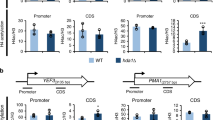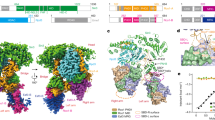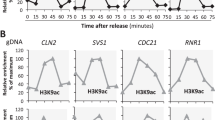Abstract
The histone deacetylase RPD3 can be targeted to certain genes through its interaction with DNA-binding regulatory proteins. RPD3 can then repress gene transcription1,2,3,4,5,6. In the yeast Saccharomyces cerevisiae, association of RPD3 with the transcriptional repressors SIN3 and UME6 results in repression of reporter genes containing the UME6-binding site3. RPD3 can deacetylate all histone H4 acetylation sites in cell extracts7. However, it is unknown how H4 proteins located at genes near UME6-binding sites are affected, nor whether the effect of RPD3 is localized to the promoter regions. Here we study the mechanism by which RPD3 represses gene activity by examining the acetylation state of histone proteins at UME6-regulated genes. We used antibodies specific for individual acetylation sites in H4 to immunoprecipitate chromatin fragments. A deletion of RPD3 or SIN3, but not of the related histone-deacetylase gene HDA1, results in increased acetylation of the lysine 5 residue of H4 in the promoters of the UME6-regulated INO1 (ref. 8), IME2 (ref. 3) and SPO13 (ref. 9) genes. As increased acetylation of this residue is not merely a consequence of gene transcription, acetylation of this site may be essential for regulating gene activity.
This is a preview of subscription content, access via your institution
Access options
Subscribe to this journal
Receive 51 print issues and online access
$199.00 per year
only $3.90 per issue
Buy this article
- Purchase on Springer Link
- Instant access to full article PDF
Prices may be subject to local taxes which are calculated during checkout





Similar content being viewed by others
References
Hassig, C. A. et al. Histone deacetylase activity is required for full transcriptional repression by mSin3A. Cell 89, 341–347 (1997).
Laherty, C. D. et al. Histone deacetylases associated with the mSin3 corepressor mediate mad transcriptional repression. Cell 89, 349–356 (1997).
Kadosh, D. & Struhl, K. Repression by Ume6 involves recruitment of a complex containing Sin3 corepressor and Rpd3 histone deacetylase to target promoters. Cell 89, 365–371 (1997).
Nagy, L. et al. Nuclear receptor repression mediated by a complex containing SMRT, mSin3A, and histone deacetylase Cell 89, 373–380 (1997).
Heinzel, T. et al. Acomplex containing N-CoR, mSin3 and histone deacetylase mediates transcriptional repression. Nature 387, 43–48 (1997).
Alland, L. et al. Role for N-CoR and histone deacetylase in Sin3-mediated transcriptional repression. Nature 387, 49–55 (1997).
Rundlett, S. E. et al. HDA1 and RPD3 are members of distinct yeast histone deacetylase complexes that regulate silencing and transcription. Proc. Natl Acad. Sci. USA 93, 14503–14508 (1996).
Slekar, K. H. & Henry, S. A. SIN3 works through two different promoter elements to regulate INO1 gene expression in yeast. Nucleic Acids Res. 23, 1964–1969 (1995).
Strich, R. et al. UME5 is a key regulator of nitrogen repression and meiotic development. Genes Dev. 8, 796–810 (1994).
Hecht, A., Strahl-Bolsinger, S. & Grunstein, M. Spreading of transcriptional repressor SIR3 from telomeric heterochromatin. Nature 383, 92–96 (1996).
Kasten, M. M., Dorland, S. & Stillman, D. J. Alarge protein complex containing the yeast Sin3p and Rpd3p transcriptional regulators. Mol. Cell. Biol. 17, 4852–4858 (1997).
Zhang, Y. et al. Histone deacetylases and Sap18, a novel polypeptide, are components of a human Sin3 complex. Cell 89, 357–364 (1997).
Mitchell, A. P. Control of meiotic gene expression in Saccharomyces cerevisiae. Microbiol. Rev. 58, 56–70 (1964).
Grunstein, M. Histone function in transcription. Annu. Rev. Cell Biol. 6, 643–678 (1990).
Luger, K., Mader, A. W., Richmond, R. K., Sargent, D. F. & Richmond, T. J. Crystal structure of the nucleosome core particle at 2.8 Å resolution. Nature 389, 251–260 (1997).
Dean-Johnson, M. & Henry, S. A. Biosynthesis of inositol in yeast. Primary structure of myo-inositol-1-phosphate synthase (EC5.5.1.4) and functional analysis of its structural gene, the INO1 locus. J. Biol. Chem. 264, 1274–1283 (1989).
Mann, R. K. & Grunstein, M. Histone H3 N-terminal mutations allow hyperactivation of the yeast GAL1 gene in vivo. EMBO J. 11, 3297–3306 (1992).
Guthrie, C. & Fink, G. R. Guide to Yeast Genetics and Molecular Biology (Academic, San Deigo, CA, 1991).
Kayne, P. S. et al. Extremely conserved histone H4 N terminus is dispensable for growth but essential for repressing the silent mating loci in yeast. Cell 55, 27–39 (1988).
Laman, H., Balderes, D. & Shore, D. Disturbance of normal cell cycle progression enhances the establishment of transcriptional silencing in Saccharomyces cerevisiae. Mol. Cell. Biol. 15, 3608–3617 (1995).
Flomerfelt, F. A., Briehl, M. M., Dowd, D. R., Dieken, E. S. & Miesfeld, R. L. Elevated glutathione S-transferase gene expression is an early event during steroid-induced lymphocyte apoptosis. J. Cell. Physiol. 154, 573–581 (1993).
Strahl-Bolsinger, S., Hecht, A., Luo, K. & Grunstein, M. SIR2 and SIR4 interactions differ in core and extended telomeric heterochromatin in yeast. Genes Dev. 11, 83–93 (1997).
Clarke, D. J., O'Neill, L. P. & Turner, B. Selective use of H4 acetylation sites in the yeast Saccharomyces cerevisiae. Biochem. J. 294, 557–561 (1993).
Vidal, M., Strich, R., Esposito, R. E. & Gaber, R. F. RPD1 (SIN3/UME4) is required for maximal activation and repression of diverse yeast genes. Mol. Cell. Biol. 11, 6306–6316 (1991).
Acknowledgements
We thank S. Henry for discussions and R. Gaber for plasmid pMV117. This work was supported by Public Health Service grants from the NIH (to M.G.).
Author information
Authors and Affiliations
Corresponding author
Rights and permissions
About this article
Cite this article
Rundlett, S., Carmen, A., Suka, N. et al. Transcriptional repression by UME6 involves deacetylation of lysine 5 of histone H4 by RPD3. Nature 392, 831–835 (1998). https://doi.org/10.1038/33952
Received:
Accepted:
Published:
Issue Date:
DOI: https://doi.org/10.1038/33952
This article is cited by
-
Promoting genotype-independent plant transformation by manipulating developmental regulatory genes and/or using nanoparticles
Plant Cell Reports (2023)
-
A short guide to histone deacetylases including recent progress on class II enzymes
Experimental & Molecular Medicine (2020)
-
Promoter recruitment of corepressors Sin3 and Cyc8 by activator proteins of the yeast Saccharomyces cerevisiae
Current Genetics (2017)
-
Global alterations of the transcriptional landscape during yeast growth and development in the absence of Ume6-dependent chromatin modification
Molecular Genetics and Genomics (2015)
-
Is the “Histone Code” an Organic Code?
Biosemiotics (2014)
Comments
By submitting a comment you agree to abide by our Terms and Community Guidelines. If you find something abusive or that does not comply with our terms or guidelines please flag it as inappropriate.



